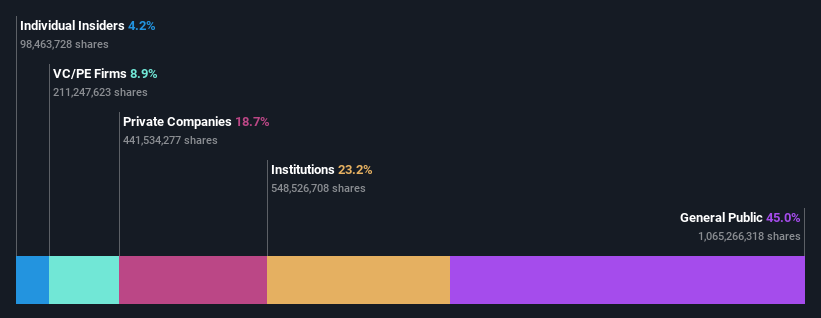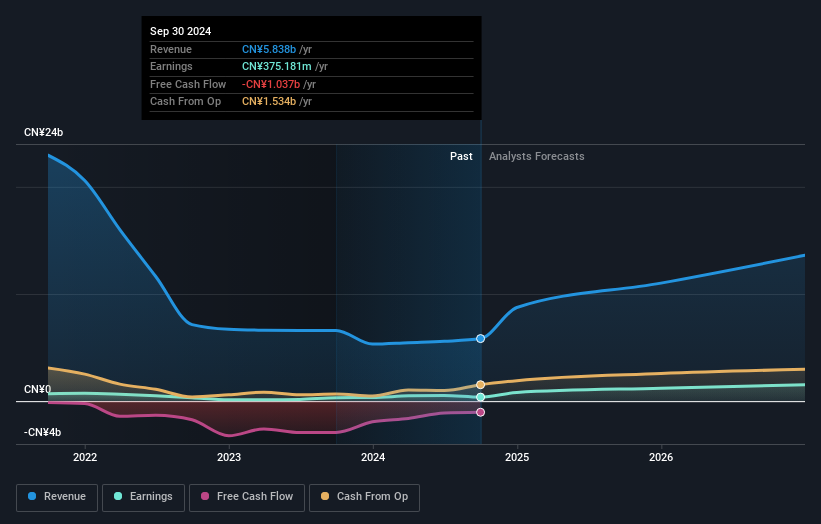- China
- /
- Commercial Services
- /
- SZSE:000035
Painful week for retail investors invested in China Tianying Inc. (SZSE:000035) after 4.4% drop, institutions also suffered losses

Key Insights
- Significant control over China Tianying by retail investors implies that the general public has more power to influence management and governance-related decisions
- 51% of the business is held by the top 12 shareholders
- Institutional ownership in China Tianying is 23%
To get a sense of who is truly in control of China Tianying Inc. (SZSE:000035), it is important to understand the ownership structure of the business. And the group that holds the biggest piece of the pie are retail investors with 45% ownership. Put another way, the group faces the maximum upside potential (or downside risk).
While institutions who own 23% came under pressure after market cap dropped to CN¥12b last week,retail investors took the most losses.
Let's take a closer look to see what the different types of shareholders can tell us about China Tianying.
View our latest analysis for China Tianying

What Does The Institutional Ownership Tell Us About China Tianying?
Many institutions measure their performance against an index that approximates the local market. So they usually pay more attention to companies that are included in major indices.
As you can see, institutional investors have a fair amount of stake in China Tianying. This can indicate that the company has a certain degree of credibility in the investment community. However, it is best to be wary of relying on the supposed validation that comes with institutional investors. They too, get it wrong sometimes. If multiple institutions change their view on a stock at the same time, you could see the share price drop fast. It's therefore worth looking at China Tianying's earnings history below. Of course, the future is what really matters.

We note that hedge funds don't have a meaningful investment in China Tianying. Looking at our data, we can see that the largest shareholder is Nantong Qianchuang Investment Co., Ltd. with 15% of shares outstanding. CECEP Huayu Fund Management Co., Ltd. is the second largest shareholder owning 8.9% of common stock, and Ping An of China Asset Management (Hong Kong) Company Limited holds about 4.1% of the company stock.
After doing some more digging, we found that the top 12 have the combined ownership of 51% in the company, suggesting that no single shareholder has significant control over the company.
Researching institutional ownership is a good way to gauge and filter a stock's expected performance. The same can be achieved by studying analyst sentiments. There is a little analyst coverage of the stock, but not much. So there is room for it to gain more coverage.
Insider Ownership Of China Tianying
The definition of an insider can differ slightly between different countries, but members of the board of directors always count. Company management run the business, but the CEO will answer to the board, even if he or she is a member of it.
I generally consider insider ownership to be a good thing. However, on some occasions it makes it more difficult for other shareholders to hold the board accountable for decisions.
Shareholders would probably be interested to learn that insiders own shares in China Tianying Inc.. This is a big company, so it is good to see this level of alignment. Insiders own CN¥486m worth of shares (at current prices). It is good to see this level of investment by insiders. You can check here to see if those insiders have been buying recently.
General Public Ownership
The general public-- including retail investors -- own 45% stake in the company, and hence can't easily be ignored. While this size of ownership may not be enough to sway a policy decision in their favour, they can still make a collective impact on company policies.
Private Equity Ownership
With an ownership of 8.9%, private equity firms are in a position to play a role in shaping corporate strategy with a focus on value creation. Some might like this, because private equity are sometimes activists who hold management accountable. But other times, private equity is selling out, having taking the company public.
Private Company Ownership
It seems that Private Companies own 19%, of the China Tianying stock. It's hard to draw any conclusions from this fact alone, so its worth looking into who owns those private companies. Sometimes insiders or other related parties have an interest in shares in a public company through a separate private company.
Next Steps:
While it is well worth considering the different groups that own a company, there are other factors that are even more important. Consider for instance, the ever-present spectre of investment risk. We've identified 1 warning sign with China Tianying , and understanding them should be part of your investment process.
Ultimately the future is most important. You can access this free report on analyst forecasts for the company.
NB: Figures in this article are calculated using data from the last twelve months, which refer to the 12-month period ending on the last date of the month the financial statement is dated. This may not be consistent with full year annual report figures.
New: AI Stock Screener & Alerts
Our new AI Stock Screener scans the market every day to uncover opportunities.
• Dividend Powerhouses (3%+ Yield)
• Undervalued Small Caps with Insider Buying
• High growth Tech and AI Companies
Or build your own from over 50 metrics.
Have feedback on this article? Concerned about the content? Get in touch with us directly. Alternatively, email editorial-team (at) simplywallst.com.
This article by Simply Wall St is general in nature. We provide commentary based on historical data and analyst forecasts only using an unbiased methodology and our articles are not intended to be financial advice. It does not constitute a recommendation to buy or sell any stock, and does not take account of your objectives, or your financial situation. We aim to bring you long-term focused analysis driven by fundamental data. Note that our analysis may not factor in the latest price-sensitive company announcements or qualitative material. Simply Wall St has no position in any stocks mentioned.
About SZSE:000035
China Tianying
Engages in urban environmental service and energy businesses in China and internationally.
High growth potential with proven track record.
Market Insights
Community Narratives




